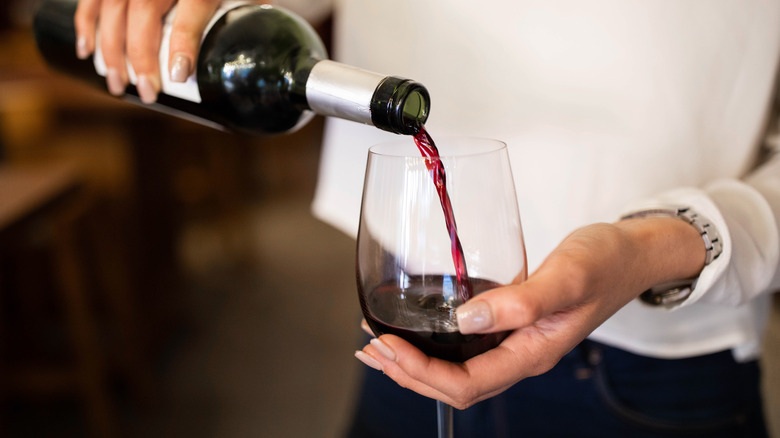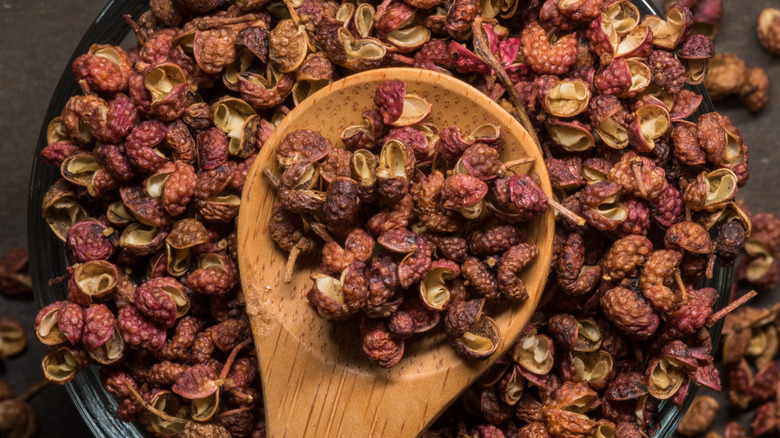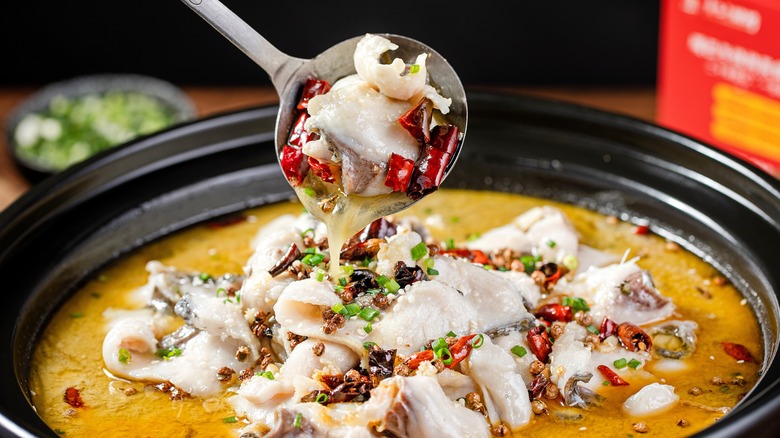The Spice A Sommelier Says Is Almost Impossible To Pair With Wine
Pairing wine is part art, part science, and part choose-your-own-adventure. Since even familiar wines vary by vintage due to weather and other variables, a wise sommelier is sometimes needed to find the perfect match. However, even seasoned sommeliers who know all the essential tips and tricks for pairing wine can struggle to find a bottle to go with certain spices. For Scott Mattson, co-owner and sommelier of Nocturne in Denver, Colorado, the spice he finds nearly impossible to match with wine is the Sichuan peppercorn.
Sichuan peppercorn (also known as Szechuan peppercorn), is a small, berry-like fruit often ground for use in regional Chinese cooking, which can be reddish or green in hue. The little but powerful spice is known for its pleasant citrusy, floral flavor and a unique buzzing sensation on the tongue. This zingy quality makes it especially challenging to pair with wine. "It's a unique ingredient, that has its place, but as a sommelier trying to navigate it, I am definitely not a fan," shares Mattson.
Why is the Sichuan pepper so hard to pair with wine
The electrifying qualities of the Sichuan peppercorn stem from its chemical makeup. "It contains hydroxy-alpha sanshool, which numbs the tongue and makes wine taste and feels very odd on the palate," explains Scott Mattson. Hydroxy-alpha sanshool is a chemical compound in the Sichuan peppercorn that blocks sensation on the tongue, causing numbness and, therefore, dulling the flavor of wine. The sensation can be equated to chili peppers' pervasive burn but with a buzzing sensation instead of a heat sensation.
Popular dishes utilizing Sichuan peppercorns are often specifically labeled Sichuan or Szechuan, but some, like mapo tofu, are not. While you may think you'd never go for a dish that numbs your tongue, if you've had five-spice powder in anything, you've experienced its effects. Many Chinese dishes feature this balanced combination of cloves, fennel, cinnamon, star anise, and Sichuan peppercorn that leaves the barest tingle. You might not even notice it, but a wine could clash with it. The next time you sit down to Sichuan chicken with green beans or five-spice chicken wings, be aware your wine could taste very different than what you expect.
How to pair wine with spicy, numbing foods
Pairing wine with spicy or numbing foods is possible, but it requires an understanding of grape properties, alcohol level, and wine origin. In general, stick to the basics: Opt for red wine with heavier meats and white wine with fish or chicken. To amp up the flavor, choose a wine with high acidity. The acid will help to counteract the numbing quality of the spice and wake up the palate.
Be sure to avoid wines that are overly high in alcohol, as they will further numb the tongue. Alcohol percentages can vary and will be printed on the bottle; anything over 13.5% is generally considered high. Skip bold wines like California cabernet sauvignon, California chardonnay, and Australian shiraz. Instead, go for something lighter, like prosecco or riesling if you want a white. Beaujolais and a low-alcohol pinot noir are also good options.
Region matters as well, as warm-climate wines tend to develop higher alcohol levels and lower acidity than cold-weather wines. So if spice is on the plate, find something from a colder region to match. With this knowledge, you can navigate virtually any wine list.


